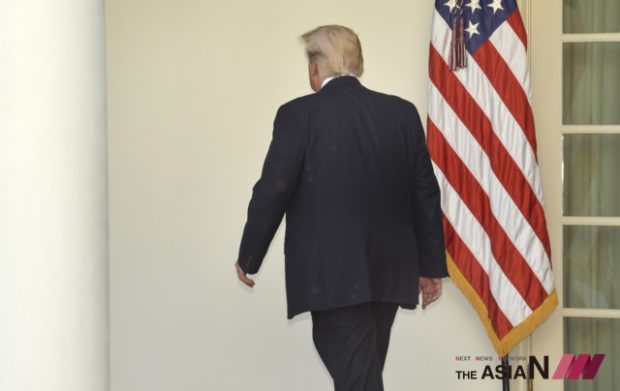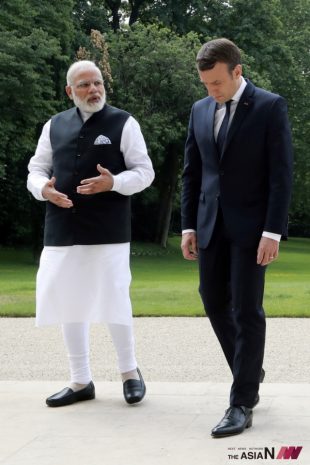Climate change: India and Donald Trump

President Donald Trump leaves after delivering a speech at the White House in Washington D.C., capital of the United States, on June 1, 2017. U.S. President Donald Trump said on Thursday that he has decided to pull the United States out of the Paris Agreement, a landmark global pact to fight climate change. (Photo : Xinhua/NEWSis)
Folk tales in any culture of the world provide wisdom. It is always wise to give heed to them. One story in the Indian folktales, “Panchatantra”, goes like this…
Once there was a king, who had a pet monkey. This monkey was a fool, but was treated royally and moved freely in the king’s palace.
He was also allowed to enter the king’s personal rooms that were forbidden even for the confidential servants.
One afternoon, the king was asleep, while the monkey kept a watch. All of a sudden, a fly came in the room and sat on the king’s chest. The monkey swayed it away, but the fly would only go away for some time and return on the king’s chest again.
The monkey got very angry and excited. The foolish monkey started chasing the fly with a sword. As the fly sat on the king’s chest again, the monkey hit the fly with all his might. The fly flew away unharmed, but the king was severely wounded.
The moral of the story is, “Beware of a foolish friend. He can cause you more harm than your enemy”.
Global statecraft is becoming more complex in these times. It has become so important to watch friends / leaders, who head governments around the world.

French President Emmanuel Macron, right, speaks with Indian Prime Minister Narendra Modi, in the gardens of the Elysee Palace in Paris, France, Saturday, June 3, 2017. Macron and the prime minister of India put forth a common front on the need to fight climate change on Saturday, with the French leader saying he would travel to India before year’s end for a summit on promoting solar energy. (Photo : AP/NEWSis)
While pulling his country out of the Paris Climate Change Agreement, US President Donald Trump had singled out India and China in his statement. He said, “India makes its participation contingent on receiving billions and billions and billions of dollars in foreign aid from developed countries”. In other words, he meant, that the American economy and its people are being ripped off by countries like India. A direct attack without any camouflage.
Making the position of India known to the world, the Indian External Affairs Minister, Ms. Sushma Swaraj, issued a rebuttal. She said, “India signed the Paris pact not because of pressure from any country nor due to the lure of money. Our signature was not because of greed. We signed it due to our commitment to protect the environment.”
Since December 2015, 195 members of the UNFCCC have signed the agreement and as many as 148 countries have even ratified it.
Centre for Climate and Energy Solutions (C2ES) has produced a comprehensive fact sheet of India’s climate and energy policies. The fact sheet examines India’s overarching climate goals, and specific policies and targets within the energy and transportation sectors.
It is indeed the fourth largest greenhouse gas (GHG) emitter, accounting for 5.8 percent of global emissions. India’s emissions increased by 67.1 percent between 1990 and 2012. If the growth trajectory remains the same, it would grow to 85 percent by 2030.
However, this is one side of the story. To reduce the emissions drastically, India will have to make huge investments in the renewable energy sector. In any case India’s emissions are relatively low compared to those of other major economies of the world including America.
According to Power Minister, Piyush Goyal, “India, under Prime Minister Modi’s leadership, has taken up renewable energy as an article of faith and is steadfast on its Paris commitments, irrespective of what others do,”
Harsh Vardhan, the Environment Minister of India, said, “The world’s third largest greenhouse gas emitter was committed to ensure it did its best to address climate change and global warming”.
According to some reports, India accounts for only 4 percent of global cumulative energy-related emissions since 1850, compared to 16 percent and 15 percent for the United States and China. India produces about 2 tons of CO2 per capita, versus 20 tons and 8 tons, respectively, in the United States and China.
On a per capita basis, the United States in 2015 produced more than double the carbon dioxide emissions of China – and eight times as much as India. United States has been burning coal, oil and natural gas for longer periods than any other country in the world. It is estimated that the US is responsible for about one-third of the excess carbon dioxide in the earth’s environment causing climate change. Ironically, the US has only four per cent of world’s population. It saw a two percent jump in carbon emission last year after showing decline for years.
As a friend of India, before ranting, President Trump would have done well if he had looked at global warming in a historical perspective of the industrial revolution of the 1800s in developed countries.
India remains committed to the Paris agreement to tackle climate change regardless of what other countries do. The Indian government stated this on Friday, after US President Donald Trump announced he would withdraw the United States from the landmark global pact.
Each country set its own commitments under the Paris agreement, so President Donald Trump’s comment is disturbing. He could unilaterally change the commitments offered by President Barack Obama, which is technically allowed under the accord.
In the Paris Agreement, India set a target of reducing use of fossil fuel by 40 per cent by 2030. According to the national electricity plan, 57 percent of power generation in the country will be sourced from non-fossil sources by 2027. India would be exceeding its target by almost 50 percent and that too, three years ahead of committed schedule.
President Trump would do well and read up the woes of the legacy of Industrial Revolution of the 1800s. It would be wise to let the US continue to be a good friend in the march for environmentally friendly development that India has embarked upon.



























































